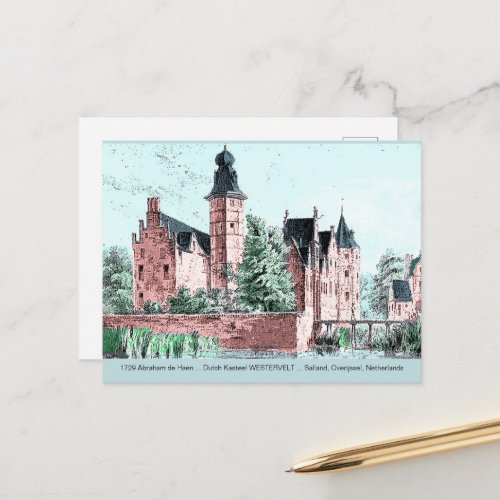1729 A. de Haen Dutch Kasteel WESTERVELT Postcard



1729 Abraham de Haen Dutch Kasteel WESTERVELT ... Colorized by Mark Edward Westerfield ... www.zazzle.com/markewesterfield 2022. Our family name Westerfield in America originated from the Dutch van Westervelt / van Westerveld / van Westerveldt name... after one of the largest Dutch castles in the Region of Salland / Salaland / Zallandt, Overijssel Province, Netherlands ... just N of Zwolle ... SW and W of River Vecht ... SE and E of River Zwarte Water ... E of River Ijssel. You can find where with Google Maps. Most importantly historically, in 1606 the ruler of Salland and owner of this Dutch Castle defeated the Spanish invader Spinola preventing him from crossing these rivers to Zwolle. Rulers of Salland living here were commissioned by the Prince of Orange. Westervelt / Westerveld / Westerveldt (various spellings found on antique maps and other documents) existed some 300 years from before 1519 and by 1600 was greatly expanded to Dutch Castle status to help to defend the Region of Salland and Zwolle from the invading Spanish Spinola ... and sold for demolition in 1816. Artist Abraham de Haen drew this image in pen and ink in 1729 ... I colorized this March 25 - 26, 2022. In its place today is Westerveldse Bos (Forest) park and Westerveldse Kolk (Lake). As it so happens, Salland ... the countryside around the Rivers Ijssel, Zwarte Water, and Vecht was according to historian Zosimus the earliest known place of origin of the tribe Salii ... the Salian Franks ... circa 200 AD who generations later migrated through Gelderland W of Ijssel then by 328 AD were incorporated into the Roman Empire just SW of Gelderland and by around 500 AD Merovingian King of the Franks Clovis I began using the golden yellow fleur de lis as his symbol becoming the first French king to do so. This symbol was inspired by the Dutch golden yellow iris flowers found naturally growing on the green banks of the Dutch rivers of the Salland Region including Rivers Ijssel, Zwarte Water, and Vecht exactly where Westervelt / Westerveld / Westerveldt would be built by 1519. The van Westervelts also ruled Harderwijk in Gelderland on the Zuider Zee from their Dutch Castle (Kasteel) De Essenburgh in Hierden just E of Harderwijk in the 1600s and 1700s having inherited the rule there from previous ancestral families of Rutger van Haersolte van Westervelt (married to Josine Johanna van Wijnbergen), the van Wijnbergen, the van Speulde, the van Heuckelom, the van Arkel and others from 1231 when Count Otto II van Gelre gave Harderwijk city rights. The counts van Gelre were promoted to dukes after a marriage of one to English Princess Eleanor. The van Westervelt family coat of arms consists of three golden yellow fleurs de lis upon an emerald green shield over which a knight's arms hold a larger golden yellow fleur de lis through a gold ducal coronet crown as two upright lions of Duchy Gelre hold the shield. The rulers of Harderwijk had a gold signet ring of three fleurs de lis on a shield used to stamp the wax used to seal legal documents. The dukes of Gelre, the Prince of Orange, and all the local Protestant Calvinist Dutch noble families were familiar with Kasteel Westervelt especially in the 1606 battle against Spanish invader Spinola. The Prince of Orange had as one of his supporters and spies one Lubbert Ulger active in the region of Salland and Zwolle and who intermarried with the rulers of Salland from Westervelt ... this is undoubtedly the source of the name of our Dutch immigrant ancestors Lubbert Lubbertsen van Westervelt and his son Lubbert Lubbertsen, Jr. van Westervelt who immigrated from their cattle farm SW of Meppel Drenthe Province NE of Westervelt in 1662 with their families on the ship HOOP (HOPE) from Amsterdam to New Amsterdam (which later became New York. I found that the local Dutch rulers often intermarried repeatedly. The ancestors of van Westervelt did likewise. And I found a van Heuckelom intermarriage with family van Gelre (the dukes of Gelre / Gelderland / Geldriae / Gelder / Guelders. So, in at least this one way we are somehow related to the Dukes of Gelre which may be a reason for the gold ducal crown and two upright lions of Duchy Gelre on our family coat of arms. The gold fleurs de lis story adds interest also. Interestingly, Lubbert Ulger's father died in 1606 ... could be associated with the battle at Westervelt against Spinola? The Prince of Orange promoted the Lubbert Ulger family for their services to the Dutch freedom fighters ... And then the intermarriage of Lubbert Ulger with the van Westervelt family of the Lord of Westervelt, ruler of Salland ... The daughter of whom intermarried with another Zwolle area ruling family van Rechteren (and lived at Westervelt) ... and these families were all buried in the crypt of the Great Church of Saint Michael in Zwolle while the Harderwijk van Westervelts were buried in the tomb under the floor of the nave of the Old Church of Harderwijk where our family coat of arms was found. Information can be found for the descent from the 1662 immigrants on online copies of the 1905 book The Genealogy of the Westervelt Family ... and the complicated ancestry of the Harderwijk van Westervelts can be found in a collection of papers with the 1500s letters between Harderwijk Gerrit van Speulde with his daughter Cecilia (married to Zwolle government official) kept at the University of Leiden. The complicated intermarriages between local ruling families are described (van Haersolte van Westervelt, van Wijnbergen, van Speulde, van Heuckelom, ten Water, van Rechteren, ten Bussche. It was a daughter of a ten Bussche van Westervelt who brought Westervelt into her marriage circa 1519 to Jan Warmelo ... their son taking the name van Westervelt.


